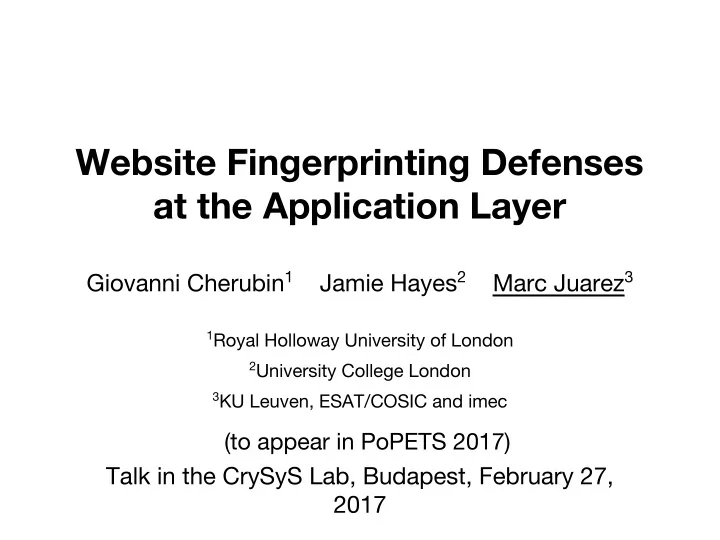

Website Fingerprinting Defenses at the Application Layer Giovanni Cherubin 1 Jamie Hayes 2 Marc Juarez 3 1 Royal Holloway University of London 2 University College London 3 KU Leuven, ESAT/COSIC and imec (to appear in PoPETS 2017) Talk in the CrySyS Lab, Budapest, February 27, 2017
Tor Tor network User Web Middle Exi Entry t 2
Website Fingerprinting (WF) Adversary Tor network User Web Middle Exi Entry t 3
Open vs Closed World Closed world Open world 4
Tor Hidden Services (HS) Introduction Point (IP) HS-I P Client xyz.onion Rendezvous Client-R Point (RP) P HS-R P HSDir 5
WF on Hidden Services • Popular examples: SecureDrops, SilkRoad, etc. • Kwon et al. (USENIX’15): HS circuit fingerprinting - The HS world can be considered a closed world • HS are especially vulnerable to WF: - Anonymity makes them suitable to host sensitive content - Smaller world makes the attack work better 6
WF defenses Adversary Tor network User y.onio n z.onion x.onio Entry n Dummy Real 7
Network- vs App-layer Defenses • Existing defenses designed at the network layer. Why? - Identifying info originates at the app layer! • Defences at the application layer: - Pros: fine-grained control in padding, no need to deal with the TCP stack. - Cons: only client and server can implement them, little incentives for servers (except for HSes!) 8
The HS world • Exploratory crawl 1 : 5K hidden services (Ahmia.fi) • Stats for the HS world (from intercepted HTTP) - Distrib. of types, sizes and number of resources - Most HS are small • Assumptions: no JS and and no 3rd-party content - 3rd party content is rare (less than 20%) - JS is rare (less than 13%) 1 https://github.com/webfp/tor-browser-seleniu m 9
LLaMA: introduction • Client-side defense • Inspired by Randomized Pipelining • Implemented as a FF add-on 1 0
LLaMA: idea Client Server • Add random delays to requests C 1 (C 2 in fig.) • Make spurious requests: C 2 C 1 - Dedicated server (not δ evaluated) ’ C 2 - Repeating previous requests (C 1 ’ in fig.) 11
Evaluation Methodology • Collect data with and without the defense: 100 HSes • Evaluation: - Security: Measure accuracy of state-of-the-art WF attacks on the collected data: k-NN, k-Fingerprinting, CUMUL - Performance: measure latency (delay in seconds) and volume (extra padding byes) overheads 1 https://github.com/webfp/tor-browser-seleniu m 12
LLaMA: results • The accuracy drops 20-30% • Less than 10% latency and bandwidth overhead Accuracy Overhead 13
ALPaCA: introduction • First server-side defense against website fingerprinting • Based on the idea that all app layer features map to size and timing at the network layer • Implemented as a cronjob in the server 14
ALPaCA: idea (1) • Pads resources (e.g., comments in HTML and adds random strings in the image’s metadata) • It pads to a match sizes and resources to a target (fake or not) page. 15
ALPaCA: idea (2) • Two ways to generate the target page: - Probabilistic (P-ALPaCA): sample the number of resources and sizes from the empirical distributions - Deterministic (D-ALPaCA): takes params δ, λ ‣ Pad the page objects to multiples of δ ‣ Create a number of fake objects to the next multiple of λ objects 16
ALPaCA: evaluation • 60-40% decrease in accuracy Accuracy • 50% latency and 86% volume overheads Overhead 17
Limitations and Future Work • ALPaCA can only make sites bigger, but not smaller • What’s the optimal padding at the app layer? Lack of a thorough feature analysis • How do distributions change over time? How do we update our defenders accordingly? - How does the strategy need be adapted as HSes adopt our defense(s)? 18
Take aways • App-layer defenses require a server-side component but are easier to implement • SecureDrop case • Source code up and running in hidden service: 3tmaadslguc72xc2.onion • GitHub: github.com/camelids 19
Thanks for your attention! 20
Recommend
More recommend